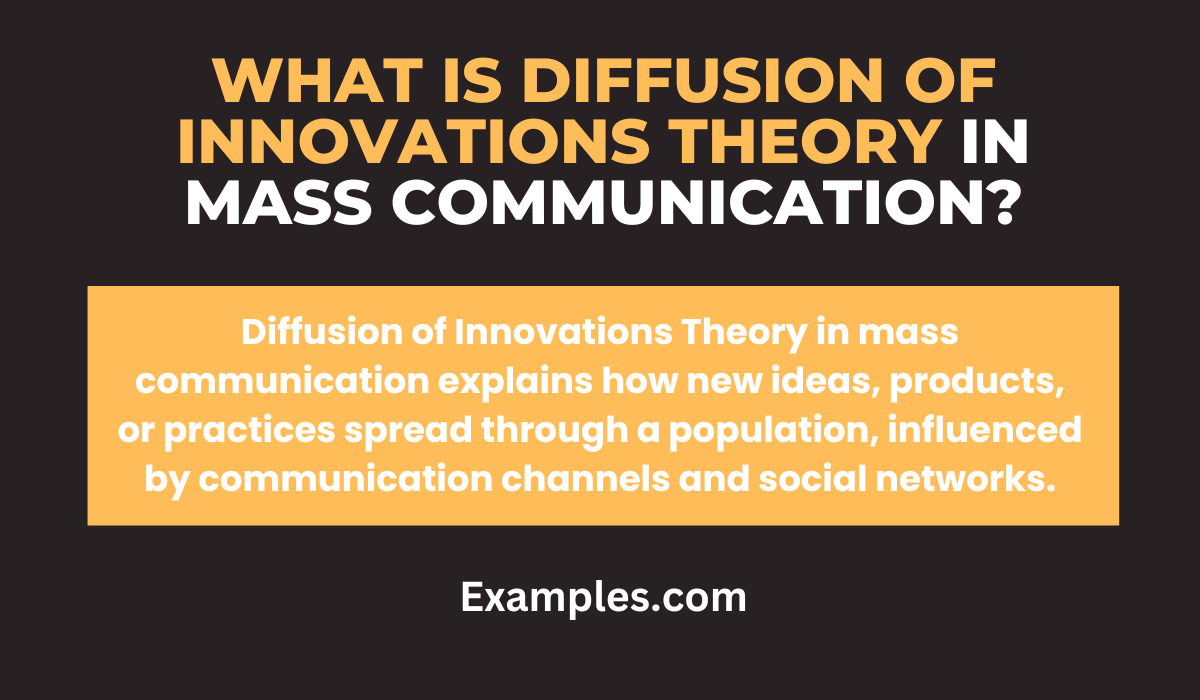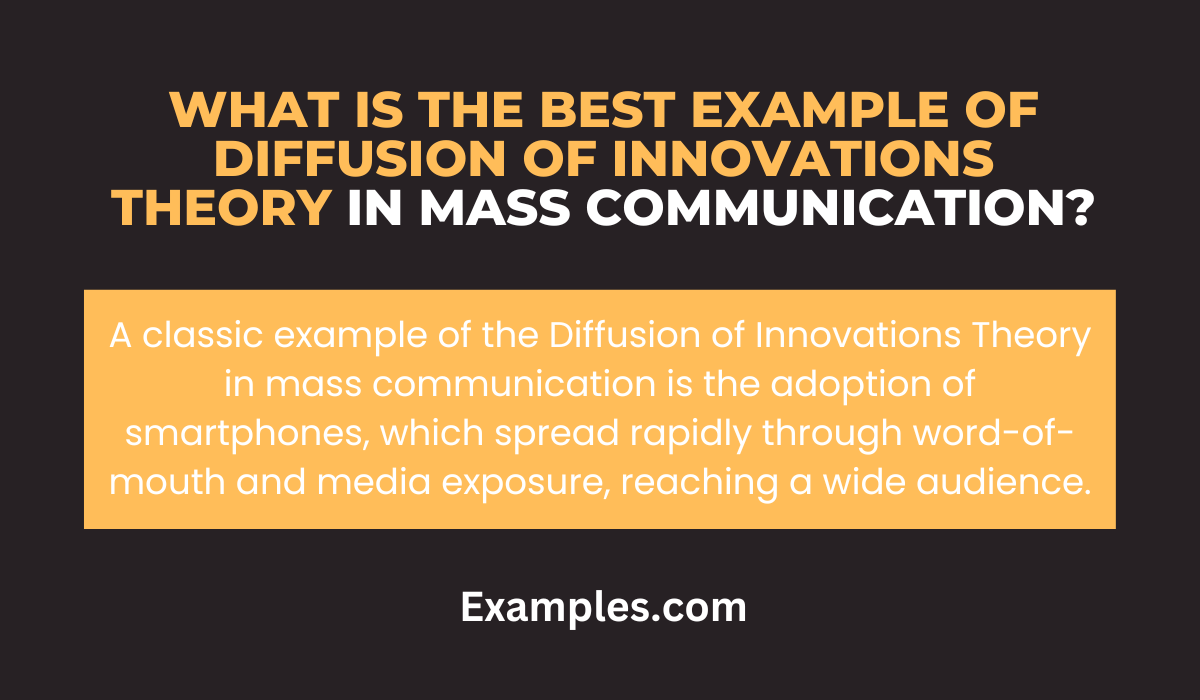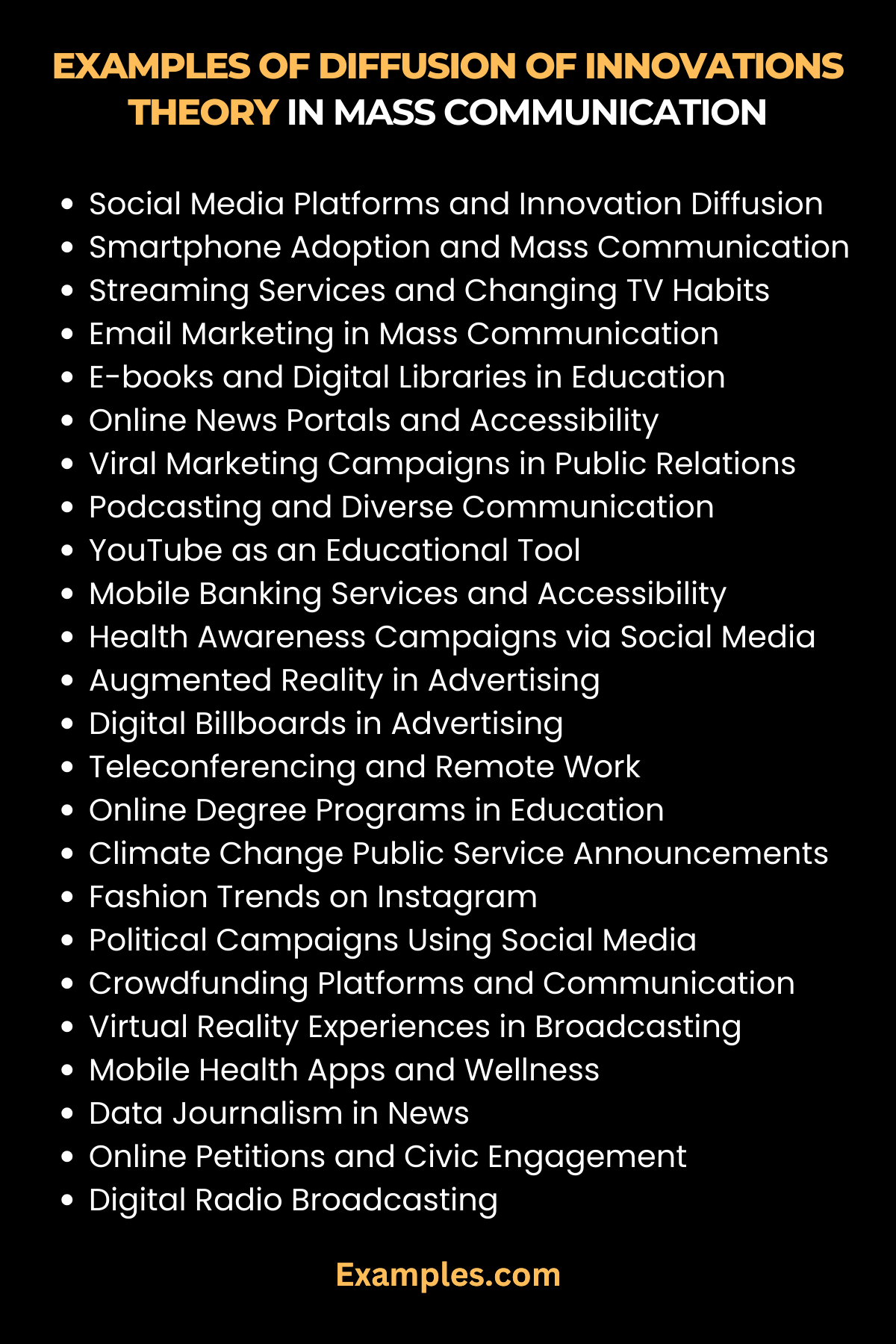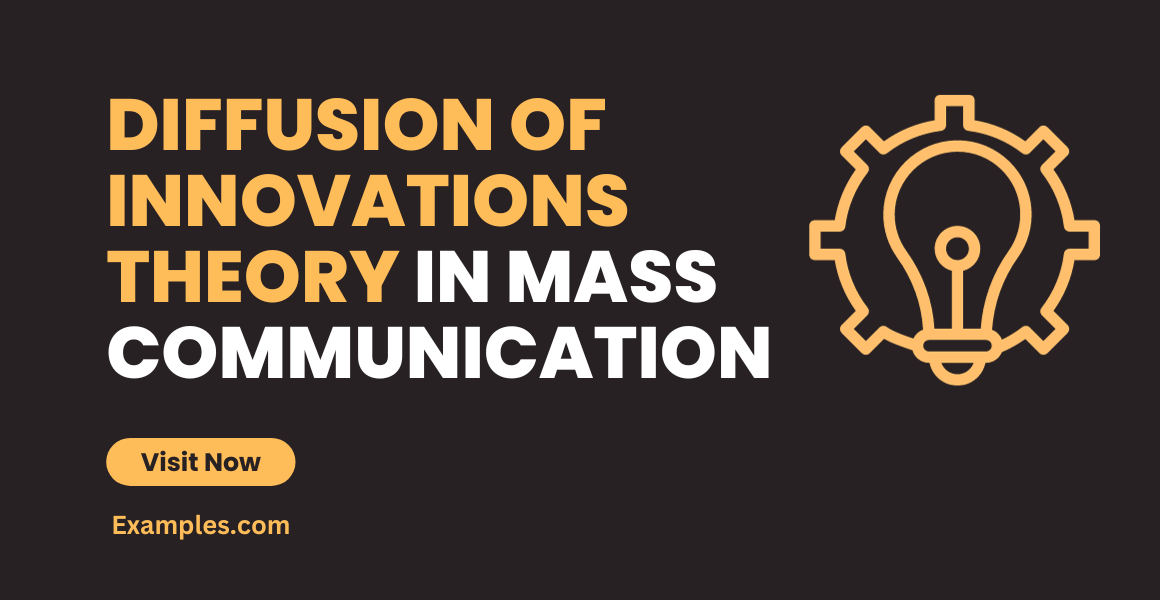Diffusion of Innovations Theory in Mass Communication
Discover the fascinating world of Diffusion of Innovations Theory within the realm of Mass Communication. This comprehensive guide offers insightful examples and practical tips, shedding light on how ideas spread in media landscapes. From classic advertising to cutting-edge digital platforms, learn how this theory shapes the way we perceive and interact with mass media. Perfect for students, educators, and professionals, this article provides a deep dive into the dynamic intersection of communication and innovation.
What is Diffusion of Innovations Theory in Mass Communication?
Diffusion of Innovations Theory in Mass Communication is a fundamental concept that explains how new ideas, technologies, or practices spread within a society or from one culture to another. It delves into the process by which an innovation is communicated through certain channels over time among members of a social system. This theory is crucial in understanding the dynamics of Mass Communication Examples and the Mass Communication Characteristics that influence how innovations gain traction and become integrated into everyday life. From the way news spreads on social media to the adoption of new technologies in broadcasting, this theory offers valuable insights into the patterns and strategies of communication in our increasingly connected world.

History of Diffusion of Innovations Theory in Mass Communication
The Diffusion of Innovations Theory is a pivotal model in the field of mass communication, outlining how new ideas and technologies spread through cultures. Developed by sociologist Everett Rogers in 1962, the theory describes the adoption of innovations in four key stages: invention, diffusion (or spread), adoption, and consequences. This model has profoundly impacted how scholars and professionals understand the spread of new ideas and technologies in society, particularly within the realms of mass communication.
What is the Best Example of Diffusion of Innovations Theory in Mass Communication?
The Diffusion of Innovations Theory, formulated by Everett Rogers, explains how, over time, an idea or product gains momentum and spreads through a specific population or social system. In mass communication, this theory is exemplified in numerous ways, but one standout example is the rise of social media platforms.
Social Media as a Prime Example: The growth of platforms like Facebook, Twitter, and Instagram epitomizes the Diffusion of Innovations Theory. Initially, these platforms were adopted by a small group of users. Over time, as awareness and understanding of their benefits increased, a larger segment of the population began to use them. These early adopters played a crucial role in influencing others, showcasing the platforms’ potential in connecting people, sharing information, and even shaping public opinion.
Key Stages in the Diffusion Process: This example clearly demonstrates the five stages of the diffusion process – knowledge, persuasion, decision, implementation, and confirmation. Social media’s journey from a novel idea to a global phenomenon follows these stages. The initial users explored and understood the platforms (knowledge), which led to more people getting persuaded to try them out. Decisions were made to adopt these platforms, leading to their widespread implementation. Finally, the continued use of these platforms, despite the emergence of new alternatives, confirms their acceptance and integration into everyday life.
Impact on Mass Communication: The rise of social media has revolutionized mass communication. It has shifted the paradigm from traditional forms of broadcasting and printing mass communication to more interactive and personalized forms. The platforms allow for mass personal communication, where messages can be tailored and targeted to specific audiences, yet have the potential to reach a global audience.

30 Examples of Diffusion of Innovations Theory in Mass Communication
Diffusion of Innovations Theory in mass communication explores how new ideas, practices, or products gain momentum and spread within a society. This theory, integral to understanding mass communication dynamics, emphasizes the role of media and interpersonal networks in shaping public opinion and behavior. Its relevance is evident in the rapidly evolving digital landscape, where innovations continuously reshape how information is disseminated and consumed.

- Social Media Platforms: The rise of platforms like Facebook and Twitter exemplifies rapid innovation diffusion, transforming Mass Personal Communication.
- Smartphone Adoption: Smartphones quickly became a staple in daily life, revolutionizing Mass Communication in Real Life.
- Streaming Services: Services like Netflix altered television viewing habits, showcasing Mass Communication in Broadcasting.
- Email Marketing: The transition from traditional mail to email for marketing demonstrates Email Mass Communication.
- E-books and Digital Libraries: This shift highlights changing preferences in Mass Communication in School.

- Online News Portals: Represent a significant change in Journalism Mass Communication, making news more accessible.
- Viral Marketing Campaigns: These campaigns use social media to create buzz, an effective strategy in Public Relations Mass Communication.
- Podcasting: The rise of podcasting as a personal yet widespread communication form shows the diversity in Forms of Mass Communication.
- YouTube as an Educational Tool: Its use in classrooms revolutionized Mass Communication Examples in School.
- Mobile Banking Services: This innovation significantly changed Mass Communication in Real Life, making banking more accessible.
- Health Awareness Campaigns via Social Media: These campaigns demonstrate Social media Mass Communication effectiveness in public health.
- Augmented Reality in Advertising: This technology offers novel ways for Mass Communication in Advertising.
- Digital Billboards: Replacing traditional billboards, they represent an evolution in Billboard Mass Communication.
- Teleconferencing and Remote Work: This shift highlights the flexibility and necessity of Mass Communication in a Digital Age.
- Online Degree Programs: They exemplify Mass Communication Examples in School, offering new learning avenues.
- Public Service Announcements on Climate Change: These represent Mass Communication Messages with a global impact.
- Fashion Trends Spread Through Instagram: This phenomenon shows Social media Mass Communication influencing consumer behavior.
- Political Campaigns Using Social Media: Illustrate the changing landscape of Mass Communication in Real Life.
- Crowdfunding Platforms: These platforms demonstrate a novel approach to Mass Personal Communication.
- Virtual Reality Experiences: Emerging VR technology is reshaping Mass Communication in Broadcasting.
- Mobile Health Apps: Represent a new frontier in Mass Communication in Real Life, promoting wellness.
- Data Journalism: This emerging field transforms Journalism Mass Communication by integrating data analysis.
- Online Petitions: They reflect the power of Social media Mass Communication in civic engagement.
- Digital Radio Broadcasting: Signifies a shift in Broadcasting Mass Communication, adapting to new technologies.
- Influencer Marketing: This strategy shows the evolving nature of Public Relations Mass Communication.

- Interactive Educational Software: Changes the dynamics of Mass Communication Examples in School.
- 3D Printing News: This innovation introduces a novel aspect to Printing Mass Communication.
- Wearable Tech in Fitness: Illustrates a unique intersection of technology and Mass Communication in Real Life.
- Online Forums for Mental Health: Show the expansion of Mass Personal Communication in health discussions.
- Automated News Aggregation: This technology impacts Mass Communication in Journalism by customizing news feeds.
Role of Diffusion of Innovations Theory in Mass Communication
- Identifying Key Players in Communication Networks: The theory categorizes individuals into innovators, early adopters, early majority, late majority, and laggards, based on their readiness to adopt new technologies or ideas. This categorization helps mass communicators target their strategies according to the audience’s receptiveness.
- Guiding Mass Media Strategies: Mass communicators use the theory to develop and refine strategies for introducing new concepts or technologies to the public. For example, the initial focus might be on innovators and early adopters, who are more likely to embrace new ideas and share them with others.
- Enhancing the Adoption of Technologies and Ideas: In mass personal communication, the theory assists in predicting and enhancing the rate at which new technologies or ideas are adopted by the masses. For instance, the rise of social media platforms can be analyzed through this theory.
- Improving Public Health Campaigns: In the context of public relations mass communication, the theory is used to improve the effectiveness of public health campaigns by understanding how information about new health practices spreads through different segments of the population.
- Influencing Education and Training: Educational institutions and training centers often apply the Diffusion of Innovations Theory to incorporate new teaching methods and technologies into their curriculums, particularly in mass communication examples in school.
- Assisting in Policy Making: Policymakers utilize the theory to gauge the likely success of new policies and to strategize their communication efforts for broader acceptance and implementation.
- Shaping News Reporting and Journalism: In journalism mass communication, the theory guides how news outlets introduce and report on new events or technologies, focusing on how their audiences might perceive and adopt the information.
- Understanding Market Trends: Businesses and marketers apply the theory to predict market trends and consumer behavior, especially in launching new products or services.
- Facilitating Global Communication: The theory plays a crucial role in understanding how global trends spread, aiding communicators in crafting messages that resonate across different cultures and societies.
- Adapting to Technological Changes: In an era of rapid technological advancement, the theory helps mass communicators adapt to and leverage new media forms, such as blog mass communication or email mass communication.
By understanding the Diffusion of Innovations Theory, professionals in mass communication can more effectively spread ideas, technologies, and practices, thereby shaping public opinion and behavior. This theory remains integral in analyzing and predicting the dynamics of communication and innovation in modern society.
Importance of Diffusion of Innovations Theory in Mass Communication
The Diffusion of Innovations Theory, conceptualized by Everett M. Rogers in 1962, is pivotal in understanding how, why, and at what rate new ideas and technology spread in society. In the realm of Mass Communication, this theory provides a framework for analyzing how an innovation, be it a product, a service, or a thought, gains momentum and diffuses through a specific population or social system.
Key Elements of the Theory
- Innovation: Any new idea, practice, or object perceived as new by an individual or other unit of adoption.
- Communication Channels: The means through which news about the innovation is transmitted.
- Time: The duration it takes for an innovation to be adopted.
- Social System: The community or group among which the innovation spreads.
Relevance in Mass Communication
- Gauging Audience Response
Understanding diffusion of innovations aids in predicting how an audience will receive a new media product or a communication strategy. - Tailoring Communication Strategies
By knowing which stage of adoption the target audience is in, communicators can tailor their messages accordingly. - Enhancing Efficiency in Information Dissemination
Knowing the diffusion process allows for more effective and efficient dissemination of information, ensuring it reaches the intended audience at the right time. - Predicting Media Trends
The theory helps in predicting future trends in media, aiding in the creation of content that resonates with the audience’s future needs.
Applications in Real-Life Scenarios
The theory finds its application in various aspects of mass communication:
- Public Relations Mass Communication: Crafting PR strategies that align with the stages of innovation adoption.
- Social Media Mass Communication: Understanding how information spreads through social networks.
- Journalism Mass Communication: Reporting news in a way that caters to different segments of the audience based on their adoption stage.
- Broadcasting Mass Communication: Developing broadcasting content that appeals to innovators and early adopters initially, followed by the early majority and late majority.
How to Use Diffusion of Innovations Theory in Mass Communication
- Identifying Target Audiences: The theory emphasizes understanding various adopter categories. Mass communication professionals can tailor their strategies to target these different groups effectively. For instance, early adopters might be more receptive to new trends in Social media Mass Communication, whereas late majority adopters might respond better to traditional Television Mass Communication.
- Effective Messaging: The theory underscores the importance of crafting messages that resonate with different segments of the audience. By understanding the characteristics and preferences of each adopter group, communicators can develop more persuasive and relevant content.
- Utilizing Varied Communication Channels: A critical aspect of this theory is the role of communication channels. Mass communicators should employ a mix of channels – from traditional Broadcasting Mass Communication to Digital Platforms like blogs and social media – to ensure the broadest possible reach and impact.
- Monitoring Adoption Rates: By keeping an eye on how quickly and widely an innovation is being adopted, mass communicators can adjust their strategies in real-time. This could involve shifting focus to different audience segments or modifying the message.
- Influence of Social Systems: Understanding the social systems in which individuals operate is crucial. For instance, in a Mass Communication Scenario/Situation in schools, the influence of peers and educators can be significant in the adoption of new communication tools or platforms.
- Creating Feedback Loops: Encouraging feedback and engagement from the audience can help in understanding the effectiveness of communication strategies and in making necessary adjustments.
- Long-Term Planning: The theory suggests that adoption is a process that occurs over time. Mass communication strategies should, therefore, be designed with a long-term perspective, keeping in mind the gradual nature of diffusion.
By incorporating the principles of the Diffusion of Innovations Theory, mass communication professionals can enhance the effectiveness of their campaigns, ensure a wider reach of their messages, and foster a deeper understanding of audience behavior and preferences. This strategic approach is particularly relevant in a rapidly evolving media landscape where staying ahead of the curve is critical.



